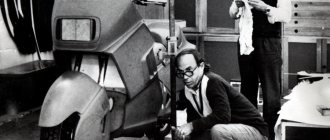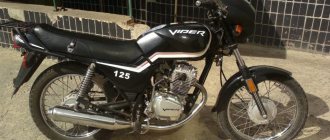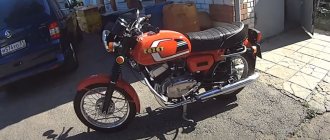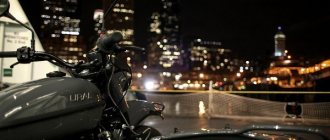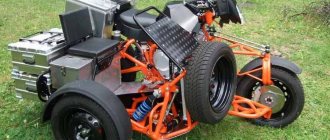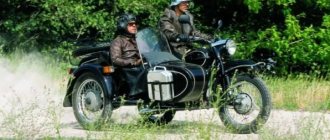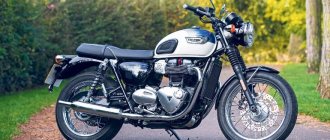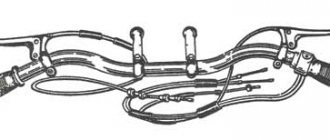Celentano and Han Solo rode: how Kyiv motorcycles conquered the world - PHOTO
Not everyone knows that in Kyiv, in the second half of the 20th century, motorcycles and even cars were actively produced. Moreover, some products became world famous, appearing in popular films. 44.ua journalists decided to talk in more detail about the history of the plant where motorcycles were produced, as well as their current condition.
History of the Kyiv Motorcycle Plant
The company was founded after the war, in 1945, on the basis of the armored repair plant No. 8, located in the Shevchenkovsky district of Kyiv. The first motorcycle was made according to drawings and using equipment exported from Germany as part of reparations in November 1946. This was the K-1B Kievlyanin model, based on the Wanderer-1Sp prototype. The Sachs 98 engine was used there.
Motorcycle “Kievlanin”, Photo: Wikipedia
Already in 1947, the plant began to produce engines independently, rather than importing them from Germany. They also produced a three-wheeled motorized wheelchair for the disabled K-1V and a cargo motorcycle K1-G.
In 1949, the Gorky Motorcycle Plant was liquidated. And about 100 specialists from there went to Kyiv to produce the heavy military motorcycle M-72. Since 1956, KMZ began to produce an improved model K-750 with a side “cradle”. Until 1970, 45-50 thousand units were produced per year.
Motorcycle "Dnepr K-750", Photo: Wikipedia
In 1968, production of the K-650 model began, which was called “Dnepr”. Later, these motorcycles were repeatedly improved. For example, in 1972, production of the MT-10 began, with an updated gearbox and the presence of reverse gear. Since 1977, MT 10-36 appeared, and since 1984 - Dnepr-16. By 1991, a new batch of single-seat models with a 650 cm³ engine was released.
Export of Kyiv motorcycles
Products for export began to be manufactured at the motorcycle plant in Kyiv in 1976. In 1978, a batch of 25 MT-14/9s was sent to the Kremlin. This motorcycle was manufactured until 1989. It was a high-quality model, capable of accelerating to 130 km/h.
But exports were carried out not only to other countries of the Union, but also to Europe, America, and even Australia. In total, they were sold to 50 countries around the world. To this day, there are even fan clubs of KMZ motorcycles in the USA, Italy, Canada, Poland, Germany, Belgium, Spain, France, Australia, and more. In total, over decades of work, almost 2.5 million motorcycles were produced (not only for export). They are still valued in the world and are quite popular.
Cars at the Kiev Motorcycle Plant
Moreover, the plant in question even tried to make cars. For example, in 1959, the development of small trucks for stores called KMZ-1 “Kyiv” was underway. They were equipped with low-power motorcycle engines, but had a cargo platform and rear-wheel drive.
Car KMZ-4 “Kyiv”, Photo: Wikipedia
In 1960, the KMZ-3 “Kyiv” series was even released, with a two-seater aluminum cabin and a wooden platform. Some of the parts were borrowed from the Zaporozhets ZAZ-965 passenger car. Later, KMZ-4 with a metal platform and KMZ-5 with a light weight of 525 kg were produced. However, the cars from the plant were experimental, and despite a good idea, they did not go into mass production.
Car KMZ-5 “Kyiv”, Photo: Livejournal
Closing of the Kyiv Motorcycle Plant
After 1991, the plant became a joint-stock company and was the only enterprise in Ukraine producing heavy-duty motorcycles. There were opportunities for manufacturing products at all cycles, from the creation of parts to the complete assembly of finished motorcycles. This is what was done until 2008, while the plant was operating. In 2004, “Dnepr-11” was even included in the TOP 100 best products in Ukraine.
However, August 2012 is listed as liquidation of production. In 2008, they decided to sell the plant, and it suffered losses in production. By 2009, these losses had increased. In 2012, 90% of the shares were sold with the condition that the enterprise continue to operate, but it was no longer carried out.
Motorcycle parts store “Dnepr” in Kyiv, Photo: Vadim Derkach
In 2016, only a company store operated from the plant, and in 2017 the last batch of “Dnepr Vintage” was produced, after which, in 2018, the equipment was removed, and on the street. The Khokhlov family, 8, were left with factory buildings without production systems. However, the official website kmz.com.ua is still working, and it lists a list of services, including repair and production, and the Dnepr Moto spare parts store is located at a well-known address.
Kyiv motorcycles in popular films
In many ways, KMZ motorcycles gained their popularity thanks to the films in which they starred. And these are paintings from the USSR, and even Hollywood and Italian works. At KMZ M72, in the film “Beware of the Car,” the main character Yuri Detochkin is caught up by a policeman played by Georgy Zhzhenov. In general, 5 different motorcycles appear in the film. Policemen also ride Kyiv motorcycles in the film “Queen of the Gas Station.” These are early models of KMZ K-750.
Kiev motorcycle in the film “Queen of the Gas Station”, Photo: frame from the film “Queen of the Gas Station”, club of a native Kiev resident
As for foreign films, KMZ motorcycles appeared in at least two Italian films with Adriano Celentano. In the film "Ace", for example, his transport is the Dnepr-10-36, which is presented as a respectable transport.
Kiev motorcycle in the film “Ace” Photo: frame from the film “Ace”
Kiev motorcycle in the film “Ace” Photo: frame from the film “Ace”
Celentano went to the red KMZ and in the film “We Bet,” where the famous Italian actor played a priest. By the way, this choice is connected with the fact that Dnepr motorcycles were promoted by an Italian distribution company. Thanks to good advertising, the actor Adriano himself actually purchased such a motorcycle.
Kiev motorcycle in the film “We Bet” Photo: still from the film “We Bet”
Kiev motorcycle in the film “We Bet” Photo: still from the film “We Bet”
No less striking was the appearance of the Kyiv motorcycle in the film Indiana Jones, where the main character in the role of Harrison Ford rode it while running away from pursuit. This actor is best known for his role as Han Solo in the Star Wars saga.
Kiev motorcycle in the movie "Indiana Jones" Photo: still from the movie "Indiana Jones", Deadline
Kiev motorcycle in the film “Indiana Jones” Photo: frame from the film “Indiana Jones”, Kiev Native Club
This is not the entire list of films in which motorcycles from the Kyiv plant were involved. They can still be seen in some music videos.
Let us remind you that earlier we also talked about Kyiv cameras and “Forge on Rybalsky”.
MY MOTORCYCLE
An honorary escort (who also served as security) is a long-standing tradition. Since ancient times, ceremonial departures of Russian tsars and receptions of foreign embassies were accompanied by detachments of archers. In the 20th century, motorcycles replaced horses.
The history of the USSR honorary escort began in 1955, when the First Secretary of the CPSU Central Committee N.S. Khrushchev gave instructions to the commandant of the Moscow Kremlin A.Ya. Vedenin to create a motorcycle platoon to ceremoniously accompany government guests. Shortly before this, Khrushchev visited Yugoslavia, and he really liked the meeting organized there with the participation of a motorcycle escort.
The M-72 motorcycle was the first to serve as an honorary escort.
The choice fell on the M-72 produced by the Kyiv Motorcycle Plant (KMZ), which became the official supplier of the 9th Directorate of the KGB of the USSR for almost four decades. The first motorcycles, judging by the surviving photographs, belonged to different factory batches produced in 1955-56, as evidenced, for example, by two types of yokes for attaching the folding part of the rear wing. These cars differed from regular production ones primarily in their special black and white paint job and a large number of chrome-plated parts (including wheel rims, rear suspension shock absorber cups and air filter covers). Almost the only “special equipment” was the electric horns on the lead motorcycle.
The first M-72 motorcycles as part of the Honorary Escort.
The baptism of fire for the motorcycle platoon of the Separate Special Purpose Regiment of the Office of the Commandant of the Moscow Kremlin (OPSN UKMK), as the motorcycle unit of the honorary escort was officially called, was the visit of Yugoslav President Josip Broz Tito to the USSR in the summer of 1956.
At the end of the 50s, tires with white-painted sidewalls appeared on escort M-72s. At the same time, shields were installed that covered the driver’s knees. In photographs taken in the winter of 1959, windshields of the same type that were later used on the K-750 can be seen for the first time. In winter, escort motorcycles were operated with side trailers. This practice has continued to this day.
Meeting of cosmonauts A.G. Nikolaev and P.R. Popovich, August 1962.
Since 1961, instead of the well-deserved M-72, K-750 motorcycles began service. During the ceremonial meeting of the first Soviet cosmonauts, an honorary escort accompanied them in new cars. This model used a modified lower valve engine, boosted to 26 hp. The chassis was new: pendulum rear suspension and short-link front forks. Structurally, the escort K-750s were not very different from the production models; the difference was more in the configuration, quality of manufacturing and assembly. They received a softer “sagging” suspension, a “high-speed” pair in the final drive gearbox and a folding side stand. Some of the cars were equipped with rear-view mirrors, sound horns and a VHF radio station installed on the right side of the rear wheel.
Meeting of the crew of the Voskhod-2 spacecraft P. I. Belyaev and A. A. Leonov, 1965.
The last production motorcycles in the honorary escort service were the K-750M (since 1967) and K-650 (since 1968). The first one differed from the K-750 by a telescopic fork, unified with the Urals, and wheel hubs with labyrinth seals. And on the K-650, practically in the same chassis, there was a new MT-8 overhead valve engine. According to the recollections of veterans, the K-650 proved to be better than previous cars: it did not have the tendency to overheat, characteristic of lower valve engines. Therefore, the drivers themselves made the replacement, rearranging the MT-8 engine into the K-750M chassis.
Experimental motorcycle K-750M with an overhead valve MT-8 engine, 1968.
The new automatic ignition advance system turned out to be a rather problematic unit. Her work was considered unsatisfactory, and the honorary escort until 1979 received motorcycles with manual ignition timing adjustment.
The motorcycles were equipped with a hard windshield shield with built-in flashing lights. Most of the cars were radio-equipped. The black and white coloring traditional for escort motorcycles has slightly changed: on the gas tanks the white stripe has become horizontal, tapering towards the rear. According to the recollections of service veterans, at the request of the drivers, the girls working in the honor escort garage painted the edging of the white stripes with golden paint with a thin artistic brush.
Since, for a number of parameters, production motorcycles no longer met the requirements of the escort service, the development of special models began in Kyiv at the end of the 60s. The first in their series was the experimental vehicle K-650ES (aka “Dnepr-ES”), which entered testing at the Serpukhov VNIIMotoprom in 1968. Structurally, it was still a modification of the serial K-650, and it is only a stretch to consider it a special motorcycle. The most noticeable difference was the 18-inch wheels, which were used on all subsequent Escort models from then on. The driver's seating position has become more comfortable thanks to the cushion saddle. The wings, side decorative shields, knee guards, and also the wind shield were made of fiberglass. The shape of these parts was carefully selected to provide the best protection for the driver from dirt and wind. For the first time, a rear roll bar appeared. The body of the side stroller was also made of fiberglass, its frame was lightweight compared to the standard one.
Motorcycle "Dnepr K-650ES" of the "Escort-73" project.
The new car was given the factory name “Escort-73”, and from that moment on, the tradition of designating escort motorcycle models by the year of the planned launch into the series was maintained until the end of production. The device turned out to be very stylish. Due to the large windshield with a protective shield, deep fenders, and an abundance of chrome parts, it stood out from production motorcycles, and therefore, while traveling in a motorcade, it perfectly demonstrated the special status of the event.
One of the first photos of the K-650 motorcycle as part of the Honorary Escort. Visit of the President of Czechoslovakia L. Svoboda, 1968.
In parallel, the department of the chief designer of KMZ carried out work on the creation of “civilian” single motorcycles, which were either simplified versions of already developed escort vehicles, or independent projects, which, in turn, often served as a source of ideas for escort topics. One of the prototypes was the Dnepr-10.6 model. The plant announced it as a “motorcycle intended for export to highly developed countries.” In fact, this car was a two-seater version of the Escort 73 in a new frame. The motorcycle received 12-volt electrical equipment. From the Escort 73, he inherited fiberglass wings and a set of rear and front safety bars.
“Intended for export to highly developed countries” motorcycle “Dnepr-10.6”.
Another experimental machine created in the mid-70s was the DneprSpecial. It was designed as a single motorcycle with a long-term focus on the American market, but we are more interested in it as an intermediate step to another prototype - the Dnepr 12.9. On the “DneprSpecial”, which was based on a new frame, the designers used a five-speed gearbox, an “unfolded” driveshaft with an elastic coupling at the main gear, previously tested on the “Dnepr-2” version, and a new air filter from a VAZ car. The motorcycle received the “Zhiguli” combination of speedometer and tachometer, which was subsequently used on all escort cars. A new front fork design was also tested on this prototype.
Experimental DneprSpecial, aimed at the US market.
The next step was the installation of a new 750 cc 50-horsepower engine (factory designation KMZ-8.153.901), created on the basis of the sports 750 SK01, into the DneprSpecial chassis. This engine was combined with a five-speed gearbox without an automatic clutch. To meet the customer’s requirements for reliable starting of the motorcycle in frosts down to -40 degrees, it was necessary to develop a special battery. The mold for it was made at KMZ, and the batteries themselves, with a capacity of 32 Ah, were made in the experimental laboratory of starter batteries at the Podolsk Battery Plant. The parameters of this battery made it possible to equip the car with an electric starter, which was placed on the left side near the gearbox. The motorcycle received a new design rodless front fork with a hydraulic steering damper. The plant also carried out work to equip the front wheel of this model (designated “Dnepr-MT12.9”) with a hydraulic disc brake.
The first 750 cc device is “Dnepr-MT12.9”.
The technical project "Dnepr-MT12.9" was reviewed by the Ministry of Automotive Industry on December 11, 1976. The vehicle received a number of comments, and in the course of eliminating them, a new model was developed - “Dnepr-14.9” (KMZ-8.953). Thus, the electronic ignition system had to be abandoned due to the low reliability of the then available element base. The engine breather received a filter element in the front engine cover. The electric starter was placed at the top of the gearbox. German Bing carburetors replaced domestic carburetors.
One of the first versions of the Dnepr-14.9 motorcycle.
The first pre-production Dnepr-14.9 was sent to the Special Purpose Garage in 1978. Based on the test results, the customer made a number of comments, which the plant tried to eliminate. However, some diseases haunted the motorcycles of this model until the end of operation. Stability and controllability at high speeds caused serious complaints. But, despite all the shortcomings, the car was a success.
President of the SFRY J.B. Tito in Moscow. The motorcade includes both K-750M and K-650 motorcycles, 1972.
The production of the first batch of 25 special escort motorcycles took more than two years, and they were delivered to the customer only in 1979. The Dnepr-14.9 engine was assembled and tuned at VNIIMotoprom in Serpukhov.
"Dnepr-14.9" from the first batch of 1979.
On December 27, 1980, the USSR Ministry of Automotive Industry approved the terms of reference for a fundamentally new motorcycle for an honorary escort - “Escort-86”. At the request of the customer organization, he had to receive a 950 cc engine with a power of at least 64.5 hp, a five-speed gearbox with reverse gear, cast wheels, a double-disc front wheel brake, a front fork with aluminum pipes and a number of other modern features. that moment of constructive decisions. In July 1983, the Kiev Motor Plant produced two prototypes for testing. The engine had to be developed virtually from scratch: it received a solid steel crankshaft with Zhiguli main and connecting rod bearings, a horizontal crankcase connector, and a camshaft chain drive. However, soon the work had to be suspended: the new motorcycle turned out to be technologically too complex for the production existing at that time.
In a report to the Scientific and Technical Council of the Ministry of Automotive Industry, Fr.
Experimental Escort-86 with engine number 38 from the author’s collection.
One can only be surprised at the peculiar logic of the “higher authorities”: the plant followed the customer’s requirements when creating a new motorcycle, and it was the designers who were accused of new developments.
The first prototype of the Escort-86 motorcycle with a 950 cc engine.
As a result, the Escort-86 project was actually reduced to a deep modernization of the Dnepr-14.9. The first two prototypes were produced and submitted for testing only in December 1986. Based on customer comments, the machines were redesigned several times, and only in 1988 the Kiev Motorcycle Plant began manufacturing a batch of 25 Dnepr-14.9M motorcycles. They differed from the previous model not only in their design, but also in their new design. The large area front fairing was now rigidly attached to the frame. At first, this created some difficulties when retraining drivers who were accustomed to “feeling a turn” by the position of the front wing. The mufflers were raised, which made it possible to tilt the motorcycle at a greater angle in turns. The electrical system provided for different switching, the use of original signal lights and a number of new instruments placed in a special container with sealed plug connectors, an instrument panel with a clock and an ammeter. To satisfy fashion requirements, the number of chrome parts was reduced. Factory engineers put a lot of effort into making the entire design of the motorcycle lighter. The rear swingarm, made of a rectangular pipe, has become longer, increasing the base of the car. The stroller has also been completely redesigned.
"Dnepr-14.9" from the second batch of 1984.
"Dnepr-14.9M" became the last escort motorcycle of the Soviet Union. In 1993, these machines in the “summer” single version were replaced by BMW K75RT motorcycles, while the “winter” version continued to serve until 1996, when it was also replaced by the BMW K75RT with a sidecar.
70s, the motorcade included Dnepr-650ES motorcycles.
To complete the picture, it is worth remembering the shipment of motorcycles for the Leningrad escort service. In the mid-80s, the customer began operating a new batch of machines and returned the previous ones to the plant. When, at the end of the decade, an escort unit appeared in the Leningrad traffic police, its chief B.N. Gavshin offered to give these motorcycles - restored and modernized - to him. Thus was born the model “Dnepr-14.9L” (KMZ-8.954), a combination of a serial 650 cc engine with components (five-speed gearbox, electric starter, chassis elements, fairings) of special escort vehicles.
"Dnepr-14.9L" for Leningrad.
Nowadays, a large collection of escort motorcycles restored by the Riga workshop “Moto-Phoenix” (team of restorers: Alexey Popov, Volodimir Seko, Andrey Silin, Vitaly Sinevich, Igor Sazonchik, Andrey Verdiyan) is in the FSO museum and periodically appears at Ilya’s Oldtimer Gallery Sorokina." Do not miss!
Motorcycle "Dnepr-14.9M".
The 1972 motorcade included K-650 motorcycles.
Issue: MOTO Magazine – March 2016
Author: Alexey POTAPOV, photo of the author, and also from the author’s archive, Special Purpose Garage, Alexander SOROKIN, Andrey MOROZENKO
Factories that produced motorcycles in the USSR (10 photos)
Author: Yugansk
28 January 2022 20:18
Community: Moto
Tags: USSR Photos. interesting mopeds scooters motorcycles
7134
10
Today we are reviewing 10 motorcycle factories. There were no fewer motorcycle factories in the USSR than automobile factories. Some became famous throughout the Union - “Izh”, “Minsk”, “Ural”, while others were known only in those regions where production was directly located. Most of the USSR's motor plants did not survive the turbulent 1990s, going bankrupt amid market competition with more advanced imported products. But others survived and today are gradually beginning to revive.
1.
0
See all photos in the gallery
"Izh". The Izhevsk Machine-Building Plant is primarily known for its weapons production, and from 1929 to 2008 it produced motorcycles, which were extremely successful and in demand in the USSR. This was the first mass production of motorcycles in the new state; At first several prototypes were made, and from 1933 the Izh-7 went into production. The picture shows Izh Planeta-2 (1964), one of the most popular models of the plant.
2.
0
"Minsk". The Minsk Motorcycle and Bicycle Plant (MMVZ) was founded in 1945 and is still operating. In 1951, the first Minsk M1A motorcycle went into production. Today the brand has an export name M1NSK and a fairly large range of models - sports, road and enduro. The picture shows the Minsk M103, produced in 1962-1964.
×
3.
0
"Ural". The Irbit Motorcycle Plant today is one of several factories in the world producing heavy side-trailer motorcycles. The plant was founded in 1941 and once made millions of Urals. He survived the 1990s and today produces very beautiful retro-style motorcycles in small series, mainly for export. Brad Pitt, for example, is a fan of the Urals. The picture shows a handsome Ural-City 2016 model year.
4.
0
"Dnieper". The Kiev Motorcycle Plant was founded in 1945 and to date has not been nominally liquidated, although production was stopped several years ago. The first model was the K-1B “Kievlyanin” light motorcycle. At the end of the 1950s, the plant also tried to produce cars, but not for long. And in the picture is the M-72 motorcycle, which was produced by the Kyiv plant according to Irbit documentation from 1950 to 1953. At that time, the plant had not yet used the proper name “Dnepr” for its models.
5.
0
"Tula". The Tula Machine-Building Plant has existed since 1879 and over its long history has produced almost everything under the sun (mainly weapons). But in 1953, it launched the production of bicycles, and three years later - motor scooters. Today TulMash no longer builds motorcycles, but its products - “Tulitsa”, “Ant”, “Tourist” - have gone down in the history of Soviet motorcycle construction. The photo shows the famous cargo scooter TGA200 “Ant”.
6.
0
"Kovrovets". The Degtyarev plant in Kovrov is an arms factory, but since 1946 it has also made motorcycles under the Kovrovets and Voskhod brands. Production has been suspended today. The picture shows “Kovrovets” K-175 (1957).
7.
0
TEEZ. The Taganrog Tool Plant (now the Taganrog Combine Harvester Plant) is one of the first pre-war motorcycle manufacturers in the USSR. True, after the war the plant never returned to the production of motor vehicles. The picture shows the main model TIZ AM-600 (1935-1943).
8.
0
"Riga". Mopeds were the desired vehicle for many young people. They were produced in Riga from 1958 to 1998. The picture shows the Riga-11 moped from 1976.
9.
0
"Carpathians". Lvov Motorcycle Plant (LMZ) was founded in 1919 as, and in 1960 it was repurposed for the production of motorcycle equipment, which it was engaged in until liquidation in 1997. It is known primarily for its “Verkhovyna” mopeds and “Karpaty” mopeds. The picture shows the mokik LMZ-2.752 “Karpaty-2”, developed in 1989 and produced in a small series. Here about motor scooters, in case you haven’t read: 9 Soviet motor scooters with European roots
10.
0
PMZ. The Podolsk Mechanical Plant became the first manufacturer of heavy motorcycles in the USSR and built the PMZ-A-750 model (pictured) from 1934 to 1939. This was the only model made in Podolsk, but to this day it remains one of the most beautiful Soviet motorcycles.
Source:
Related links:
- Do you remember? 18 eloquent photos from the dashing 90s
- Through the waves of memory: 15 household items from the times of the USSR, which have long been replaced
- Why did the Khrushchev and Stalin buildings have windows in the bathrooms?
- Toilet paper in the USSR: how residents of the Soviet Union were weaned from using “newspaper”
- Get out of the USSR. What happened to famous models from the 90s
subscribe to the Moto community
Tags: USSR Photos. interesting mopeds scooters motorcycles
Do you like to remember how things were before? Join us, let's feel nostalgic together:
82 4 78
Liked
78 1
42
Partner news

